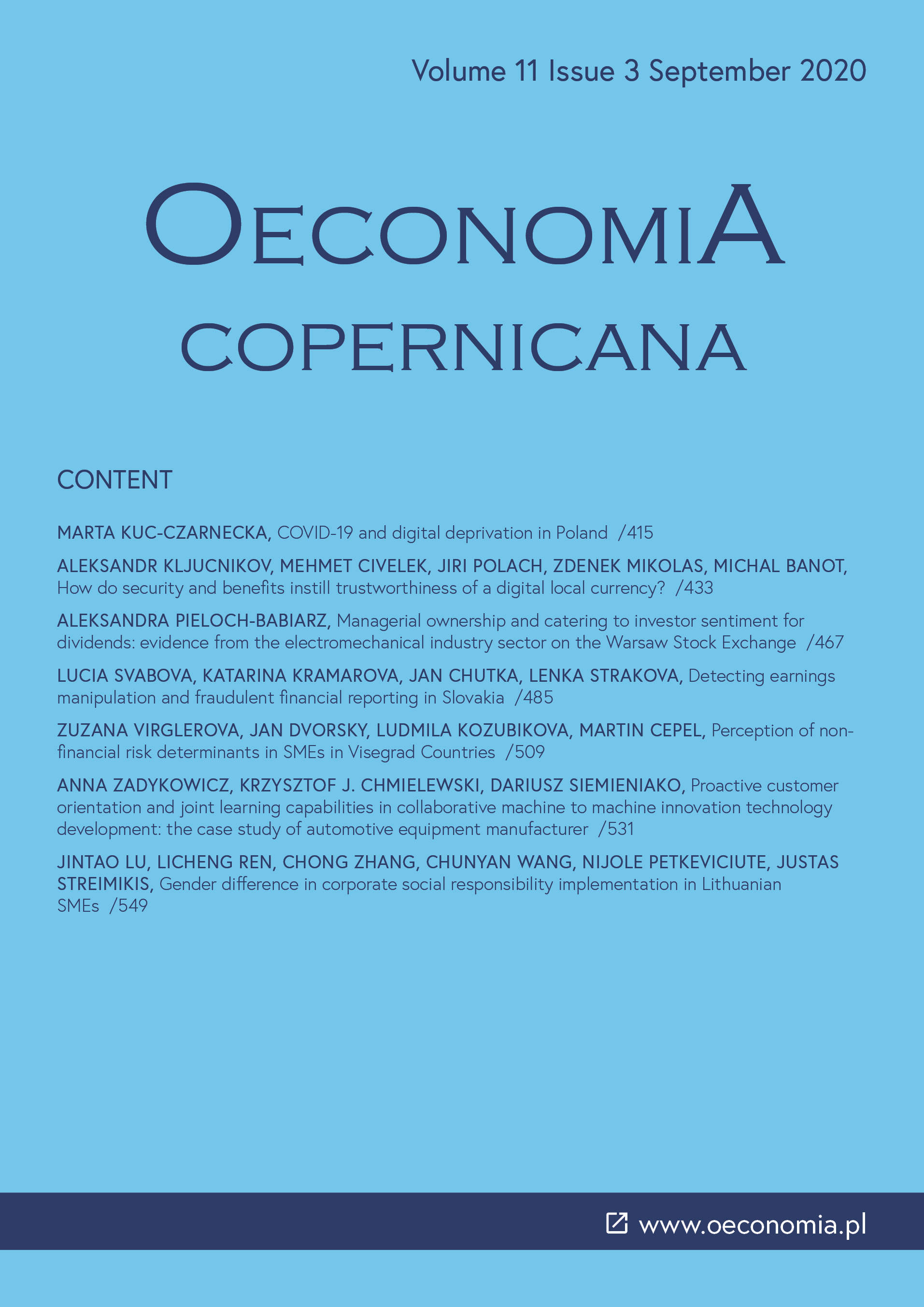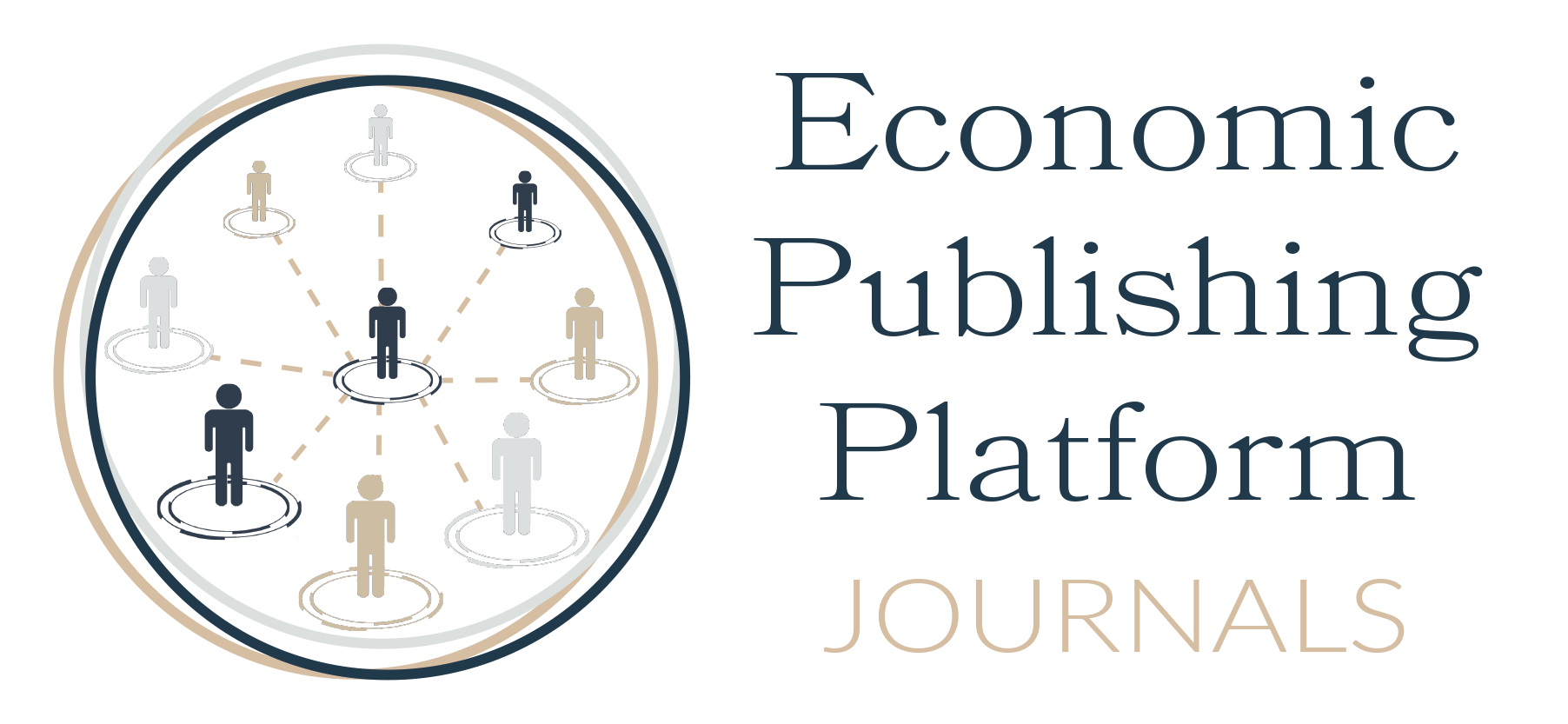Proactive customer orientation and joint learning capabilities in collaborative machine to machine innovation technology development: the case study of automotive equipment manufacturer
DOI:
https://doi.org/10.24136/oc.2020.022Keywords:
proactive customer orientation, industrial information technology, joint learning capability, collaborative innovation development, expert power dimensionAbstract
Research background: There is a considerable amount of literature focused on customers? motivation to participate in cooperative new product development [NPD], but previous research neglected the suppliers? perspective concerning organizational mechanisms for the facilitation of customer involvement in cooperative new product development.
Purpose of the article: The aim of the study is to explore the influence of two kinds of dynamic capabilities, proactive customer orientation [PCO] and joint learning capability [JLC] on the acceptance and use of machine to machine interaction [M2M] in collaborative innovation development [CID], from the supplier?s perspective.
Methods: The research is based on a case study carried out from June 2018 till June 2019 of a Polish automation integrator supplying a manufacturer of automotive equipment, i.e. automotive industry, in a fully robotized workstation. In order to understand how the company functions in this case, in-depth interviews with the company?s employees have been conducted.
Findings & Value added: The results revealed that intelligent devices, interacting machines, and real-time data transfer to the supplier may cause disruptions through their impact on establishing trustful business relationships. We believe our findings could have a profound impact on the way how proactive customer orientation and relational interactions supported knowledge sharing and joint learning sense-making through operational meetings and on-the-job workshops which role was to evaluate the collaborative project.
Downloads
References
Ashton, K. (2009). That ‘internet of things’ thing. RFID Journal, 22(7).
View in Google Scholar
Atuahene-Gima, K. (2005). Resolving the capability-rigidity paradox in new product innovation. Journal of Marketing, 69(4). doi: 10.1509/jmkg.2005.69.4.61.
DOI: https://doi.org/10.1509/jmkg.2005.69.4.61
View in Google Scholar
Azadegan, A., & Dooley, K. (2010). Supplier innovativeness, organizational learning styles and manufacturer performance: an empirical assessment. Journal of Operations Management, 28(6). doi: 10.1016/j.jom.2010.02.001.
DOI: https://doi.org/10.1016/j.jom.2010.02.001
View in Google Scholar
Beugelsdijk, S., Koen, C., & Noorderhaven, N. (2006). Organizational culture and relationship skills. Organization Studies, 27(6). doi: 10.1177/017084060606 4099.
DOI: https://doi.org/10.1177/0170840606064099
View in Google Scholar
Beverland, M., & Lindgreen, A. (2010). What makes a good case study? A positivist review of qualitative case research published in industrial marketing management, 1971–2006. Industrial Marketing Management, 39(1). doi: 10.1016/j. indmarman.2008.09.005.
DOI: https://doi.org/10.1016/j.indmarman.2008.09.005
View in Google Scholar
Blocker, C., Flint, D., Myers, M., & Slater, S. (2010). Proactive customer orientation and its role for creating customer value in global markets. Journal of the Academy of Marketing Science, 39(2). doi: 10.1007/s11747-010-0202-9.
DOI: https://doi.org/10.1007/s11747-010-0202-9
View in Google Scholar
Chang, K., & Gotcher, D. (2007). Safeguarding investments and creation of transaction value in asymmetric international subcontracting relationships: the role of relationship learning and relational capital. Journal of World Business, 42(4). doi: 10.1016/j.jwb.2007.06.008.
DOI: https://doi.org/10.1016/j.jwb.2007.06.008
View in Google Scholar
Cooper, R. (2019). The drivers of success in new-product development. Industrial Marketing Management, 76. doi: 10.1016/j.indmarman.2018.07.005.
DOI: https://doi.org/10.1016/j.indmarman.2018.07.005
View in Google Scholar
Cowan, K., Paswan, A. K., & Van Steenburg, E. (2015). When inter-firm relationship benefits mitigate power asymmetry. Industrial Marketing Management, 48. doi: 10.1016/j.indmarman.2015.03.013.
DOI: https://doi.org/10.1016/j.indmarman.2015.03.013
View in Google Scholar
Cuevas‐Rodríguez, G., Cabello‐Medina, C., & Carmona‐Lavado, A. (2014). Internal and external social capital for radical product innovation: do they always work well together? British Journal of Management, 25(2). doi: 10.1111/1467-8551.12002.
DOI: https://doi.org/10.1111/1467-8551.12002
View in Google Scholar
Das, T., & Teng, B.-S. (2001). Trust, control, and risk in strategic alliances: an integrated framework. Organization Studies, 22(2). doi: 10.1177/01708406012 22004.
DOI: https://doi.org/10.1177/0170840601222004
View in Google Scholar
De Clercq, D., & Sapienza, H. (2006). Effects of relational capital and commitment on venture capitalists' perception of portfolio company performance. Journal of Business Venturing, 21(3). doi: 10.1016/j.jbusvent.2005.04.007.
DOI: https://doi.org/10.1016/j.jbusvent.2005.04.007
View in Google Scholar
Doney, P., & Cannon, J. (1997). An examination of the nature of trust in buyer-seller relationships. Journal of Marketing, 61(2). doi: 10.2307/1251829.
DOI: https://doi.org/10.2307/1251829
View in Google Scholar
Ejsmont, A. (2014). Coopetition as the factor of increasing level of innovativeness in the SME sector in Poland. Oeconomia Copernicana, 5(4). doi: 10.12775/Oe C.2014.026.
DOI: https://doi.org/10.12775/OeC.2014.026
View in Google Scholar
Falkenreck, C., & Wagner, R. (2017). The internet of things – chance and challenge in industrial business relationships. Industrial Marketing Management 66. doi: 10.1016/j.indmarman.2017.08.007.
DOI: https://doi.org/10.1016/j.indmarman.2017.08.007
View in Google Scholar
Fang, E., & Zou, S. (2010). The effects of absorptive and joint learning on the instability of international joint ventures in emerging economies. Journal of International Business Studies, 41. doi: 10.1057/jibs.2009.100.
DOI: https://doi.org/10.1057/jibs.2009.100
View in Google Scholar
French, J. R., Raven, B., & Cartwright, D. (1959). The bases of social power. Classics of Organization Theory, 7.
View in Google Scholar
Geyskens, I., Steenkamp, J. E. B. M., Scheer, L. K., & Kumar, N. (1996). The effects of trust and interdependence on relationship commitment: a trans-Atlantic study. International Journal of Research in Marketing, 13(4). doi: 10.1016/S0167-8116(96)00006-7.
DOI: https://doi.org/10.1016/S0167-8116(96)00006-7
View in Google Scholar
Huikkola, T., Ylimäki, J., & Kohtamäki, M. (2013). Joint learning in R&D collaborations and the facilitating relational practices. Industrial Marketing Management, 42. doi: 10.1016/j.indmarman.2013.07.002.
DOI: https://doi.org/10.1016/j.indmarman.2013.07.002
View in Google Scholar
Jer, R., Kim, D., & Bello, D. (2017). Relationship-based product innovations: evidence from the global supply chain. Journal of Business Research, 80. doi: 10.15444/GMC2016.03.03.03.
View in Google Scholar
Kalwani, M., & Nayarandas, N. (1995). Long-term manufacturer–supplier relationships: do they pay off for supplier firms? Journal of Marketing, 59(1). doi: 10.1177/002224299505900101.
DOI: https://doi.org/10.2307/1252010
View in Google Scholar
Kannan, P., & Hongshuang, A. (2017). Digital marketing: a framework, review and research agenda. International Journal of Research in Marketing, 34(1). doi: 10.1016/j.ijresmar.2016.11.006.
DOI: https://doi.org/10.1016/j.ijresmar.2016.11.006
View in Google Scholar
Khrystoforova, V., & Siemieniako, D. (2019). Internet-based consumer co-creation experience of the new product development process. Engineering Management in Production and Services, 11(3). doi: 10.2478/emj-2019-0021.
DOI: https://doi.org/10.2478/emj-2019-0021
View in Google Scholar
Kim, D., Chiou, J. S., & Calantone, R. (2018). Strategic orientations, joint learning, and innovation generation in international customer-supplier relationships. International Business Review, 27. doi: 10.1016/j.ibusrev.2018.01.007.
DOI: https://doi.org/10.1016/j.ibusrev.2018.01.007
View in Google Scholar
Kubacki, K., Siemieniako, D., & Brennan, L. (2020). Building positive resilience through vulnerability analysis. Journal of Social Marketing. Advance online publication. doi: 10.1108/JSOCM-09-2019-0142.
DOI: https://doi.org/10.1108/JSOCM-09-2019-0142
View in Google Scholar
Lacoste, S., & Johnsen, E. (2015). Supplier–customer relationships: a case study of power dynamics. Journal of Purchasing and Supply Management, 21. doi: 10.1016/j.pursup.2014.12.006.
DOI: https://doi.org/10.1016/j.pursup.2014.12.006
View in Google Scholar
Mainela, T., & Ulkuniemi, P. (2013). Personal interaction and customer relationship management in project business. Journal of Business & Industrial Marketing, 28(2). doi:10.1108/08858621311295245.
DOI: https://doi.org/10.1108/08858621311295245
View in Google Scholar
Malhotra, A., Gosain, S., & Sawy, O. A. E. (2005). Absorptive capacity configurations in supply chains: gearing for partner-enabled market knowledge creation. MIS Quarterly, 29(1). doi: 10.2307/25148671.
DOI: https://doi.org/10.2307/25148671
View in Google Scholar
Martínez-Noyaa, A., & Narulab, R. (2018). What more can we learn from R&D alliances? A review and research agenda. BRQ Business Research Quarterly, 21(3). doi: 10.1016/j.brq.2018.04.001.
DOI: https://doi.org/10.1016/j.brq.2018.04.001
View in Google Scholar
Michalos, G., Makris, S., Papakostas, N., Mourtzis, D., & Chryssolouris, G. (2010). Automotive assembly technologies review: challenges and outlook for a flexible and adaptive approach. CIRP Journal of Manufacturing Science and Technology, 2. doi: 10.1016/j.cirpj.2009.12.001.
DOI: https://doi.org/10.1016/j.cirpj.2009.12.001
View in Google Scholar
Miorandi, D., Sicari, S., De Pellegrini, F., & Chlamtac, I. (2012). Internet of things: vision, applications and research challenges. Ad Hoc Networks, 10. doi: 10.1016/j.adhoc.2012.02.016.
DOI: https://doi.org/10.1016/j.adhoc.2012.02.016
View in Google Scholar
Mitręga, M. (2019). Dynamic marketing capability–refining the concept and applying it to company innovations. Journal of Business & Industrial Marketing, 35(2). doi: 10.1108/JBIM-01-2019-0007.
DOI: https://doi.org/10.1108/JBIM-01-2019-0007
View in Google Scholar
Momeni, K., & Martinsuo, M. (2018). Remote monitoring in industrial services: need-to-have instead of nice-to-have. Journal of Business and Industrial Marketing, 33(6). doi: 10.1108/JBIM-10-2015-0187.
DOI: https://doi.org/10.1108/JBIM-10-2015-0187
View in Google Scholar
Nagy, J., Oláh, J., Erdei, E., Máté, M., & Popp, J. (2018). The role and impact of Industry 4.0 and the Internet of Things on the business strategy of the value chain—the case of Hungary. Sustainability, 10. doi: 10.3390/su10103491.
DOI: https://doi.org/10.3390/su10103491
View in Google Scholar
Pérez-Luño, A., Medina, C., Lavado, A., & Rodríguez, G. (2011). How social capital and knowledge affect innovation. Journal of Business Research, 64(12). doi: 10.1016/j.jbusres.2011.01.014.
DOI: https://doi.org/10.1016/j.jbusres.2011.01.014
View in Google Scholar
Petersen, K., Handfield, R., & Ragatz, G. (2003). A model of supplier integration into new product development. Journal of Product Innovation Management, 20(4). doi: 10.1111/1540-5885.00028.
DOI: https://doi.org/10.1111/1540-5885.00028
View in Google Scholar
Ruey-Jer, J., Chiou, J.-S., & Sinkovics, R. R. (2016). Interpartner learning, dependence asymmetry and radical innovation in customer-supplier relationships, Journal of Business & Industrial Marketing, 31(6). doi: 10.1108/JBIM-10-2012-0185.
DOI: https://doi.org/10.1108/JBIM-10-2012-0185
View in Google Scholar
Ruey-Jer, J. Kim, D., & Bello, D. (2017). Relationship-based product innovations: evidence from the global supply chain. Journal of Business Research, 80. doi: 10.15444/GMC2016.03.03.03.
DOI: https://doi.org/10.1016/j.jbusres.2017.07.008
View in Google Scholar
Sachpazidu-Wójcicka, K. (2017). Innovation as a determinant of the competitiveness of Polish enterprises. Oeconomia Copernicana, 8(2). doi: 10.24136/oc.v8 i2.18.
DOI: https://doi.org/10.24136/oc.v8i2.18
View in Google Scholar
Santucci, G., & Lange, S. (2008). Internet of things in 2020. A roadmap for the future. Working Group RFID of the ETP EPoSS. Retrieved from https://docbox.etsi.org/erm/Open/CERP%2020080609-10/Internet-of-Things_i n_2020_EC-EPoSS_Workshop_Report_2008_v1-1.pdf (09.03.2020).
View in Google Scholar
Siemieniako, D. (2011). Relational loyalty versus obligation in complex service relationships. Marketing i Rynek, 8.
View in Google Scholar
Siemieniako, D., & Gębarowski, M. (2016). B2B relationship marketing management in trade fair activity. Newcastle: Cambridge Scholars Publishing.
View in Google Scholar
Siemieniako, D., & Gębarowski, M. (2017). B2B trade fairs and promise management as a relationship marketing concept. Journal of Customer Behaviour, 16(3). doi: 10.1362/147539217X15071081721116.
DOI: https://doi.org/10.1362/147539217X15071081721116
View in Google Scholar
Siemieniako, D., & Mitręga, M. (2018). Improving power position with regard to non-mediated power sources–the supplier's perspective. Industrial Marketing Management, 70. doi: 10.1016/j.indmarman.2017.08.013.
DOI: https://doi.org/10.1016/j.indmarman.2017.08.013
View in Google Scholar
Ślusarczyk, B., Haseeb, M., & Hussain, H. I. (2019). Fourth industrial revolution: a way forward to attain better performance in the textile industry. Engineering Management in Production and Services, 11(2). doi: 10.2478/emj-2019-0011.
DOI: https://doi.org/10.2478/emj-2019-0011
View in Google Scholar
Smals, R., & Smits, A. (2012). Value for value—the dynamics of supplier value in collaborative new product development. Industrial Marketing Management, 41(1). doi: 10.1016/j.indmarman.2011.11.022.
DOI: https://doi.org/10.1016/j.indmarman.2011.11.022
View in Google Scholar
Soosay, C. A., Hyland, P. W., & Ferrer, M. (2008). Supply chain collaboration: capabilities for continuous innovation. Supply Chain Management: An International Journal, 13(2). doi: 10.1108/13598540810860994.
DOI: https://doi.org/10.1108/13598540810860994
View in Google Scholar
Subramaniam, M., & Youndt, M. (2005). The influence of intellectual capital on the types of innovative capabilities. Academy of Management Journal, 48(3). doi: 10.5465/amj.2005.17407911.
DOI: https://doi.org/10.5465/amj.2005.17407911
View in Google Scholar
Tippins, M., & Sohi, R. (2003). IT competency and firm performance: is organizational learning a missing link? Strategic Management Journal, 24. doi: 10.100 2/smj.337.
DOI: https://doi.org/10.1002/smj.337
View in Google Scholar
Trainor, K., Krush, M., & Agnihotri, R. (2013). Effects of relational proclivity and marketing intelligence on new product development. Marketing Intelligence and Planning, 31(7). doi: 10.1108/MIP-02-2013-0028.
DOI: https://doi.org/10.1108/MIP-02-2013-0028
View in Google Scholar
Urban, G., & Hauser, J. (1993). Design and marketing of new products. Prentice Hall.
View in Google Scholar
Wang, L., Jin, J., Zhou, K., Li, C., & Yin, E. (2020). Does customer participation hurt new product development performance? Customer role, product newness, and conflict. Journal of Business Research, 109. doi: 10.1016/j.jbusres.2019. 12.013.
DOI: https://doi.org/10.1016/j.jbusres.2019.12.013
View in Google Scholar
West, J., & Bogers, M. (2014). Leveraging external sources of innovation: a review of research on open innovation. Journal of Product Innovation Management, 31(4). doi: 10.1111/jpim.12125.
DOI: https://doi.org/10.1111/jpim.12125
View in Google Scholar
Yam, R., Lo, W., Tang, E., & Lau, A. (2011). Analysis of sources of innovation, technological innovation capabilities, and performance: An empirical study of Hong Kong manufacturing industries. Research Policy, 40(3). doi: 10.1016/ j.respol.2010.10.013.
DOI: https://doi.org/10.1016/j.respol.2010.10.013
View in Google Scholar






